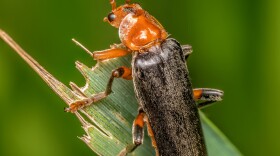The peaceful sounds of summer. Birds singing to welcome the rising sun. The chirping of crickets in a meadow. Waves lapping at the shoreline of a lake.
And depending on where you live in the United States, the chainsaw-like songs of cicadas.
Cicadas, specifically species of periodic cicadas, are thought to be the world’s loudest insects. While it may be open to debate as to which species is the champion of chatter, Brevisana brevis (an African cicada) has been recorded at 107 decibels. For comparison, a chainsaw buzzes away at 110.
Female cicadas can make noise by flicking their wings – producing a clicking sound that’s similar to when you flick on a light switch.
But when it comes to the ear-splitting ruckus these insects are best known for, it’s all about the boys.
Male cicadas have a special ribbed membrane (called a tymbal) that they can quickly vibrate using strong muscles. Popping the membrane in and out of shape produces a sound similar to the way you might use a dog training clicker. The insect’s air-filled abdomen works to amplify their buzzing.
Male cicadas use their blaring sounds to communicate with other cicadas. Their songs are used as alarm calls, territorial calls, or ballads to woo the ladies.
But as you might guess, it would hardly be worth making so much noise if your fellow cicadas couldn’t hear you. It turns out that both male and female cicadas have hearing organs called tympana.
Luckily, it’s “safety first” in regard to their hearing. Just before launching into a skull-splitting serenade, male cicadas contract a small muscle that secures a flap over their otherwise exposed eardrums.





